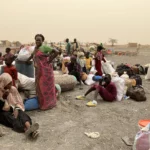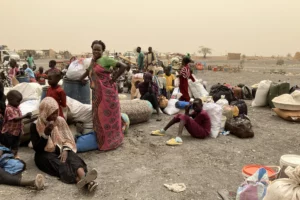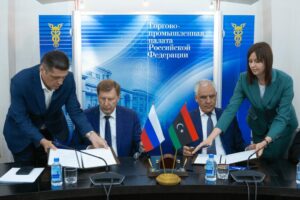Tanzania has been spared the internal strife that has blighted many African states since independence, and is regarded as one of the safest and most politically stable on the continent.
However, domestic stability has not translated into economic prosperity for Tanzanians. Many of its people live below the World Bank poverty line, although the country has had some success in wooing donors and investors.
While the country’s offshore gas reserves have remained undeveloped for many years, new political leadership since 2021 has raised hopes it may become an exporter of liquid natural gas (LNG) by 2030.
Tanzania is home to two renowned tourism destinations – Africa’s highest mountain, Kilimanjaro, and wildlife-rich national parks such as the Serengeti – but has become a target for poachers.
UNITED REPUBLIC OF TANZANIA: FACTS
- Capital: Dodoma
- Area: 947,303 sq km
- Population: 61.7 million
- Languages: Swahili, English, Arabic (only in Zanzibar)
- Life expectancy: 64 years (men) 68 years (women)
LEADER
President: Samia Suluhu Hassan

Vice-President Hassan took over in March 2021 on the death of President John Magufuli, who had caused international concern over his campaign against the independent media and other issues, including gay rights and his handling of the Covid-19 pandemic.
The government said he died of heart problems, although the opposition has alleged his death was Covid-related.
Samia Suhulu Hassan was elected as Mr Magufuli’s running mate in 2015 and again in 2020. A contrasting figure to her abrasive and impetuous predecessor, she is due to serve out the remainder of his five-year term.
MEDIA

Television is eroding radio’s traditional dominance, and media ownership is highly concentrated.
Under John Magufuli the government cracked down on its critics, including the press. Samia Suluhu Hassan, who became president after Magufuli’s death in 2021, has begun to reverse these trends.
The government has lifted bans and suspensions of several major newspapers. Freedom House says while there has been an increase in qualified criticism of the government, “self-censorship and pro-government bias remain prevalent”.
TIMELINE

Some key dates in Tanzania’s history:
1.9 million years ago – Tanzania is one of the oldest continuously inhabited areas on Earth, with traces of fossil remains of humans and hominids in the Olduvai Gorge between 1.9 million-19,000 years ago.
2,000BC onwards – waves of migration from north and from west into the region.
c. 8th-9th Century AD – Traders from the Persian Gulf and India reach the east African coast, bringing Islam to the area.
10th Century – Zanzibar grows to become one of the key Swahili trading towns along the coast.
1498 – Portuguese explorer Vasco da Gama visits Tanzanian coast. Portugal succeeds in controlling most of the East African coast, until it is ousted from Zanzibar in 1699 by Omani Arabs.
1840 – Omani Sultan Said bin Sultan moves his capital to Zanzibar, which becomes the centre for the east African slave trade.
1884 – German Colonisation Society begins to acquire territory on the mainland.
1886 – Britain and Germany sign an agreement allowing Germany to set up a sphere of influence over mainland Tanzania, except for a coastal strip under the sultan of Zanzibar, which is a British protectorate.
1888-89 – Abushiri revolt or the slave trader revolt. An uprising led by Abushiri ibn Salim al-Harthi of the Arab and Swahili population of coastal areas that had been granted to Germany, under protest, by the sultan of Zanzibar. Suppressed by German troops.
1905-07 – The Maji Maji revolt. Triggered by German colonial policies forcing locals to grow cotton for export. German forces deliberately use starvation to suppress the rebellion. Between 75,000-300,000 people die, mainly from famine.
1914-1918 – World War One.
1916 – British, Belgian and South African troops occupy most of German East Africa.
1919 – League of Nations gives Britain a mandate over Tanganyika – today’s mainland Tanzania.
1929 – Tanganyika African Association founded.
1946 – United Nations converts British mandate over Tanganyika into a trusteeship.
1954 – Julius Nyerere and Oscar Kambona transform the Tanganyika African Association into the Tanganyika African National Union.
1961 – Tanganyika becomes independent with Julius Nyerere as prime minister.
1962 – Tanganyika becomes a republic with Nyerere as president.
1963 – Zanzibar becomes independent.
1964 – Zanzibar revolution. Sultan of Zanzibar is overthrown in a violent, left-wing revolution led by the Afro-Shirazi Party. Up to 20,000 – mainly Arab inhabitants – are estimated to have been killed in the ethnic violence.
Tanganyika and Zanzibar merge to become Tanzania with Nyerere as president and Afro-Shirazi leader Abeid Amani Karume as vice-president.
1967 – Nyerere issues the Arusha Declaration, which launches a drive for socialist economic self-reliance.
1974 – Government announces plan to move capital from Dar es Salaam on the coast, to the more central city of Dodoma
1977 – Tanganyika African National Union and Zanzibar’s Afro-Shirazi Party merge to become the Party of the Revolution, which is proclaimed to be the only legal party.
1978 – Uganda temporarily occupies a piece of Tanzanian territory.
1979 – Tanzanian forces invade Uganda, occupying the capital, Kampala, and help to oust President Idi Amin.
1985 – Julius Nyerere retires.
1992 – Constitution amended to allow multi-party politics.
1995 – Benjamin Mkapa chosen as president in Tanzania’s first multi-party election.
1996 – Dodoma officially becomes the new capital of Tanzania.
1998 – Al-Qaeda Islamist terror group bombs US embassies in Tanzania and Kenya.
2001 – At least 31 people are killed in Zanzibar in protests against the government’s banning of opposition rallies calling for fresh elections.
Thousands march in the first major political demonstration in decades in the commercial capital, Dar es Salaam.
Huge new gold mine, Bulyanhulu, opens near northern town of Mwanza, making Tanzania Africa’s third largest producer of gold.
2010 – Tanzania joins its neighbours in forming a new East African Common Market, intended to integrate the region’s economy.
2012 – Major discovery of gas reserves off the coast of Tanzania.
2016 – Tanzania and Uganda agree to build east Africa’s first major oil pipeline.

Source : BBC















